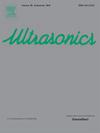自热对穿透金属超声功率传递效率影响的实验与数值研究
IF 3.8
2区 物理与天体物理
Q1 ACOUSTICS
引用次数: 0
摘要
超声波可以有效地为密封在金属外壳内的电子设备提供动力,例如小型传感器和其他电子元件。超声波功率传输(UPT)可以为这些电子设备提供能量,同时在无法穿透金属屏障进行固定充电或更换电池的情况下保持结构完整性。典型的穿金属UPT系统由两个压电换能器组成,它们对称地连接在金属屏障的两侧,其中换能器发射和接收弹性波,并在接收端将机械能转换为电能。为了使UPT系统的性能持续优化,必须了解影响其效率的损失。也就是说,UPT系统中的介电损耗和机械损耗会导致自热产生,从而显著影响UPT系统的效率。本文采用数值和实验两种方法研究了温度对UPT效率的影响。我们在不同的输入功率水平下连续驱动压电换能器,研究UPT系统的功率传输效率和温度随时间的变化。通过多物理场(电-机-热耦合)有限元模拟,估算了UPT系统的温度分布。我们量化了连续驱动UPT系统的功率传输效率如何随着温度的升高而随时间降低。此外,数值模拟表明,机械损耗是UPT系统中自热产生的主要损耗来源(与介电等相比)。我们报告的结果为优化UPT系统设计和理解自热特性提供了见解。本文章由计算机程序翻译,如有差异,请以英文原文为准。
Experimental and numerical investigation of self-heating effects on the through-metal ultrasonic power transfer efficiency
Ultrasonic waves can be efficiently used to power electronic devices sealed inside a metallic enclosure, such as small sensors and other electrical components. Ultrasonic power transfer (UPT) can provide energy to these electronics while maintaining structural integrity in situations where perforating the metallic barrier for tethered charging or battery replacement is not possible. A typical through-metal UPT system consists of two piezoelectric transducers bonded symmetrically on either side of a metallic barrier, where the transducers transmit and receive elastic waves and convert the mechanical energy into electrical energy at the receiver end. For continuous and optimal performance of a UPT system, it is imperative to understand the losses that affect its efficiency. That is, dielectric and mechanical losses within UPT systems cause self-heat generation that can significantly affect the efficiency of the UPT system. In this work, the effects of temperature on UPT efficiency are studied using both numerical and experimental methods. We drive the piezoelectric transducer continuously at various input power levels to study the power transmission efficiency and temperature of the UPT system over time. Multiphysics (coupled electro-mechanical-thermal) finite-element simulations are performed to estimate the temperature profile of the UPT system. We quantify how the power transmission efficiency of continuously-driven UPT systems decreases over time as temperature rises. In addition, numerical simulations show that mechanical losses are the dominant source of losses for the self-heat generation in the UPT system (as compared to dielectric etc.). Our reported results provide insights for optimizing UPT system design and for understanding the self-heat generation characteristics.
求助全文
通过发布文献求助,成功后即可免费获取论文全文。
去求助
来源期刊

Ultrasonics
医学-核医学
CiteScore
7.60
自引率
19.00%
发文量
186
审稿时长
3.9 months
期刊介绍:
Ultrasonics is the only internationally established journal which covers the entire field of ultrasound research and technology and all its many applications. Ultrasonics contains a variety of sections to keep readers fully informed and up-to-date on the whole spectrum of research and development throughout the world. Ultrasonics publishes papers of exceptional quality and of relevance to both academia and industry. Manuscripts in which ultrasonics is a central issue and not simply an incidental tool or minor issue, are welcomed.
As well as top quality original research papers and review articles by world renowned experts, Ultrasonics also regularly features short communications, a calendar of forthcoming events and special issues dedicated to topical subjects.
 求助内容:
求助内容: 应助结果提醒方式:
应助结果提醒方式:


